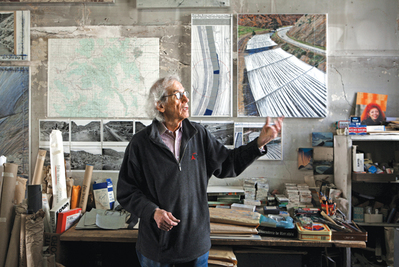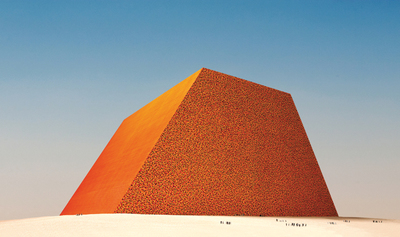Christo: Rapt in Public

Christo in his studio with a preparatory collage for Over The River, 2011. Photo: Wolfgang Volz. © 2011 Christo.
Last August, 79-year-old Christo set out in a raft down the Arkansas River, cruising the six-mile stretch in the Colorado valley where he hopes to someday suspend approximately 1,000 silvery fabric panels. This project, Over the River, has been on his mind for more than 22 years. To date, he has spent $4 million on an environmental study. He has a permit to temporarily build on the land (which he’s paid rent on for the past three years, at $87,000 yearly), yet it is currently tied up in a lawsuit. The environmentalist group Rags Over the Colorado River has sued the US government, which owns the land. While Christo awaits the judge’s decision, he keeps the conversation going. That’s why he rafted down the river—not because he’s a rafter, nor because he has any burning desire to go rafting. He simply wants to keep local supporters engaged, show his enthusiasm and further conversations surrounding this project.
This is also the reason why Christo will be lecturing in Stowe, Vermont, at Spruce Peak Performing Arts Center, on February 5. He will be talking about his ongoing projects, showing approximately 90 images and answering
public questions.
“His work is about dialogue,” says Biddle Duke, publisher of the Stowe Reporter and one of the founders of the Vermont Town Hall speaker series. Inspired by Vermont town meetings where locals discuss global issues, Duke and a few of his colleagues sought to invite creative minds into this progressive mountain community. He says, “Stowe is an incredible destination. People come here to have fun. Until now, there hasn’t been a component in the community that embraces important and compelling dialogue.” Thus, they began inviting thought-provoking speakers, including Christo.
Speaking from his studio (which, in fact, is a five-story building in downtown Manhattan), Christo talks fast, seemingly driven by a motor, and appears laser-focused on his two ongoing projects. He’s mostly concerned with Over the River. Once the judge gives him the green light, he and his staff will set into motion preparing the fabric, which will take at least a couple
of years.
The Mastaba is his second project, conceived in 1977. It would be the largest sculpture in the world, 492 feet high by 984 feet wide. Constructed from 410,000 painted oil drums forming a mosaic-like truncated pyramid, this would be Christo and Jeanne-Claude’s only permanent, large-scale installation and would sit in the desert near Abu Dhabi.
Christo, The Mastaba of Abu Dhabi (Project for United Arab Emirates), 1979, scale model: enamel paint, wood, paint, sand and cardboard, 32½ x 96 x 96″. Photo: Wolfgang Volz. © 1979 Christo.
The couple’s projects are so enormous and complex (involving teams of international engineers and technical advisors), even art experts seem baffled as to what to call them. Christo laughs, when he and Jeanne-Claude created the Wrapped Reichstag, in 1995, the New York Times sent over an architectural writer. “Well, it does involve a lot of planning—not that different from constructing a building,” he says.
For 50 years, he worked alongside his wife and partner Jeanne-Claude, who died in 2009. “It’s been a big loss,” Christo says, adding she was “very critical, very opinionated and asked straightforward questions.” All of the projects they conceived bear both of their names.
In order to understand the work, says Christo, it’s important to know that all of the installations intersect with manmade spaces—whether they’re in the desert, along the Australian coast or in the Rockies. Towns, roads, bridges, businesses, schools, gas stations and temples all become involved in the project and enter into the discussion.
For instance, in 1991, the couple installed The Umbrellas, which Christo describes as a diptych: dual installations of giant umbrellas installed simultaneously in rural California and rural Japan. According to Christo, the umbrellas were so large, 19-feet-high by 28-feet-diameter, with seating in the middle, they created the allusion of an open-sided house. “While the California people would sit under the umbrellas and picnic,” says Christo, “the Japan people would remove their shoes. That’s what they do in their homes.”
Adds Christo, “There are so many interpretations of our projects, which we cannot expect. Any interpretation is legitimate. It’s impossible to plan for that. What is revealed to the project comes from the process.”
It was back in the winter of 2005 that Biddle Duke became inspired by Christo and Jeanne-Claude, seeing The Gates in New York City—7,500 arched structures with flowing saffron fabric. They were installed in the 843-acre Central Park—originally designed by famed landscape architect Frederick Law Olmsted. “The reaction can be, how can you do this to something that’s the brainchild of another artist?” asks Duke. “Or why do care about this? There are any number of questions that come up, including our attachment to the way things should look.”
Such are the types of questions Duke hopes will be on the public’s mind when they meet Christo in February. He says, “Christo’s art and his life have forced us to look at our lives differently, to force us to think about our world in a different way.”
Debbie Hagan is editor-in-chief of Art New England.

